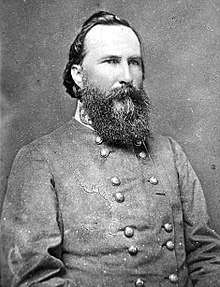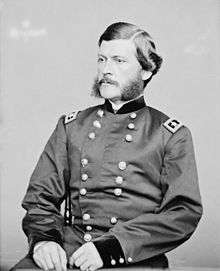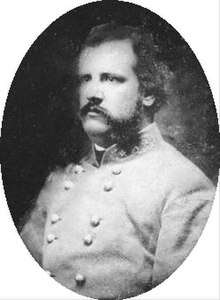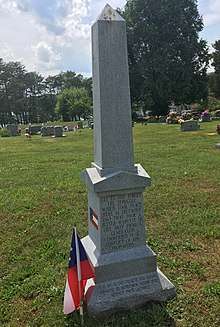Battle of Bean's Station
The Battle of Bean's Station was a battle of the Knoxville Campaign of the American Civil War, occurring on December 14, 1863, in Grainger County, Tennessee. General James Longstreet had been outside of Knoxville until December 4, when he abandoned their position and left heading Northeast. He was trailed by General John G. Parke, who had just replaced General Burnside.[4]
On December 13, General James M. Shackelford was commanding Union forces near Bean's Station on the Holston River. Longstreet decided to go back and capture Bean’s Station. Three Confederate columns and artillery approached Bean's Station to catch the Federals in a vise. By 2:00 a.m. on December 14, one column was skirmishing with Union pickets. The pickets held out as best they could and warned Shackelford of the Confederate presence. He deployed his force for an assault. Soon, the battle started and continued throughout most of the day.[4]
Confederate assaults occurred constantly, but the Union forces held until Southern reinforcements tipped the scales. By nightfall, the Federals were retiring from Bean's Station through Bean's Gap and on to Blain's Cross Roads. Longstreet attacked the Union forces again the next morning, but as he approached them at Blain's Cross Roads, he discovered that they had entrenched themselves beyond eviction. Longstreet withdrew and the Federals soon left the area. The Knoxville Campaign ended following the battle of Bean's Station. Longstreet soon went into winter quarters at Russellville, Tennessee.[3]
Background
For the past few months of 1863, the Civil War had started to turn in favor of the Federals. The Confederates lost the Battle of Gettysburg and their hope of advancing towards Washington, D.C. This is often called the High water mark of the Confederacy. The following day, the Confederates lost the city of Vicksburg to the Federals in a drawn out siege. Britain, having observed the Confederate defeat at Gettysburg, had just declined sending any aid for the rebels.[5] In September 1863, Confederate General James Longstreet had been sent by Robert E. Lee from Virginia to assist Braxton Bragg in southeast Tennessee shortly before the Chickamauga Campaign. After Bragg besieged the city of Chattanooga, a detachment led by Longstreet was sent to prevent Ambrose E. Burnside from supporting the Union troops stationed in Chattanooga. After besieging Knoxville, Longstreet attempted to break into the city, but was soundly defeated at the Battle of Fort Sanders on November 29.
Prelude
 James Longstreet, Confederate Commander
James Longstreet, Confederate Commander John Parke, Union Commander
John Parke, Union Commander
On December 4, Longstreet retreated from Knoxville and headed northeast towards Rogersville, Tennessee. Union General John G. Parke pursued the Confederate retreat into Tennessee.[3] That night the Confederates arrived at Blain's Crossroads, eighteen miles to the west of Rogersville. The successful Union commander at Knoxville, General Burnside, had been officially replaced before the Siege of Knoxville, but his replacement, Major-General John G. Foster, had been stuck outside the town during the siege.[4] On December 10 he arrived and took command of the Union forces.[6]
The Confederate army passed through Bean's Station and encamped near Rogersville. After learning that the Federal cavalry at Bean’s Station was farther ahead than the Union infantry, Longstreet attempted on December 14 to encircle the Union forces.[2] He enjoyed superior numbers and counted on surprising the Federals.[5] The southern general ordered his cavalry under the command of William Martin to move behind the enemy position at Bean’s Station to cut off their line of retreat.[7] Longstreet’s encircling movement was tactically sound but did not succeed upon execution later that day.[6]
Longstreet's plan was to move his infantry on the station from his bivouac at Rogersville. W. T. Martin with four cavalry brigades was to go down the south side of the Holston River and cross at or below the station, while "Grumble" Jones with two cavalry brigades was to go down the north side of the Clinch Mountains and cut off the Federal retreat at Bean's Station gap.[5]
The battle
First day of fighting
On the morning of December 14, Bushrod Johnson’s infantry division moved out, followed by Lafayette McLaws’s division and elements of Hood’s division. Colonel Henry Giltner’s cavalry brigade established contact with federal pickets before Bean’s Station by about 2:00 p.m., and the battle began. The Federal position, rested on both sides of the Rutledge Road.[5] The Union commander, Brig. Gen. J. M. Shackelford, positioned his artillery behind a brook on either side of the road. Confederate forces advancing from the east also positioned their artillery batteries above and below the roadway.[8]
The Confederate force, with Johnson’s Tennessee Brigade maneuvering below the road and Gen. Archibald Gracie’s Alabama Brigade above it to the north, was met with heavy fire from Federal batteries behind the creek and riflemen inside the tavern itself.[5] Confederate artillery batteries advanced to pour fire into the hotel, and Longstreet sent a brigade around Gracie’s northern flank to encircle the Union left flank.[2] Federal commanders detected the movement and decided to execute a fighting retreat towards Rutledge.[7] The Union forces retreated successfully towards Rutledge road.[8] Jones and the infantry performed their part of the operation well. However, Martin mishandled his part, and Shackelford's cavalry escaped to Blain's C.R. without more serious loss than a few wagons.
Pursuit was attempted but was futile, Longstreet maintained, because Evander Law was slow and Lafayette McLaws was loath to move before bread was issued the hungry men.
— Lee's Lts., III, 299
Second day of fighting

The next day the fighting began at about 2 p.m. when the Confederate cavalry encountered the Union pickets about three miles east of Bean's Station.[7] This soon developed in a general engagement, with Brigadier General A. Gracie's brigade in the forefront on the Confederate side. The Union cavalry was slowly forced back. One division managed to get around the Union left flank, and as darkness fell the Confederate forces were in occupation of Bean's Station.[6]
Aftermath

An attempt to cut off the retreating Union army failed when it encountered Parke's infantry.[5] The casualties totaled around 700 Union and 900 Confederate killed and wounded. Bean's Station marked the end of the fighting in the Knoxville Campaign. Despite being a Confederate victory, it had little long-term effect.[7] Longstreet had a chance to attack an isolated Union detachment, but would have needed significant reinforcements to go back on to the offensive. Instead, as the winter set in, the fighting in East Tennessee stopped. The next spring, Longstreet's men returned to the Army of Northern Virginia.[8]
Notes
- "Battle Summary: Bean's Station". American Battlefield Protection Program. Retrieved December 18, 2008.
- Smith p. 78
- Smith p. 82
- Smith p. 39
- Boatner p. 53
- Spurgeon, King. "Battle of Bean's Station". Tennessee Encyclopedia. Retrieved December 18, 2008.
- Boatner p. 54
- Rickard, J. "Battle of Bean's Station". History of War. Retrieved December 18, 2008.
References
- Smith, David (1999). Campaign to Nowhere: The Results of General Longstreet’s Move into Upper East Tennessee. Strawberry Plains Press.
- Boatner, Mark M. (1959). The Civil War Dictionary. New York: David McKay Co. pp. 53–54. ISBN 0-679-50013-8.
- Freeman, David S. (1942–1946). Lee's Lieutenants-A Study in Command. 2. Charles Scribner's Sons.
External links
- "Bean's Station, December 14, 1863". HistoryofWar.org. Archived from the original on 25 June 2006. Retrieved May 13, 2006.
- CWSAC Report Update and Resurvey
